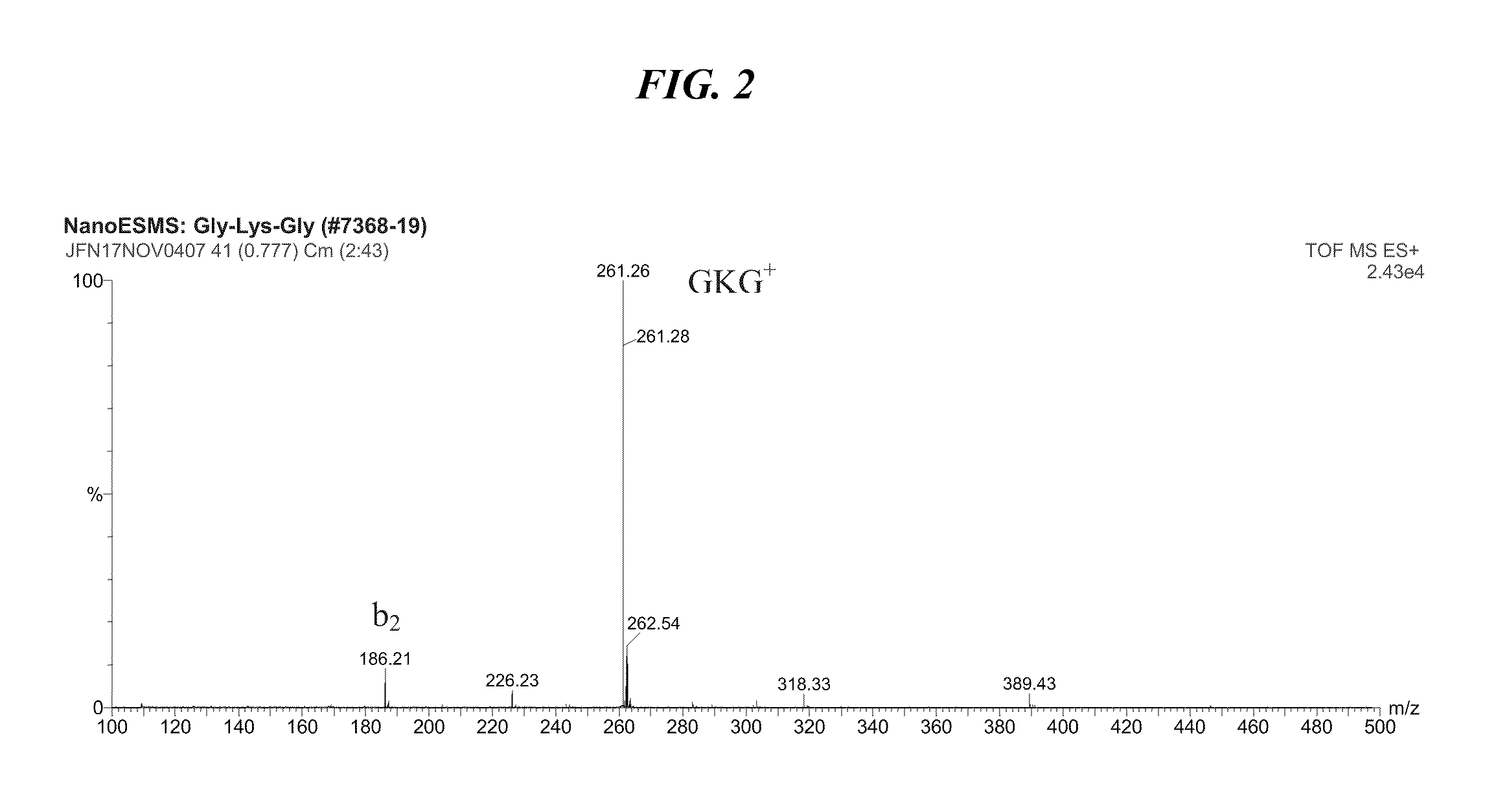Solution Synthesis of Peptide Cell Growth Stimulators
a technology of growth stimulators and peptides, applied in the field of peptide synthesis, can solve the problems of undesirable by-products, large quantities, and unfavorable reactions at the side group or the wrong terminal end of a reactant, and achieve the effect of reducing the extent of apoptosis and enhancing bioreactor productivity
- Summary
- Abstract
- Description
- Claims
- Application Information
AI Technical Summary
Benefits of technology
Problems solved by technology
Method used
Image
Examples
example 1
Preparation of Nα-Butyloxycarbonyl-L-Lysine (Nε-Benzyloxycarbonyl)-Glycine Benzyl Ester (Boc-Lys(Z)-Gly-Obzl)
[0051]The preparation of the tripeptide Gly-L-Lys-Gly was performed in a stepwise manner as shown in the accepted conventional notation shown in FIG. 1, and includes a) a first coupling b) deprotection c) second coupling d) deprotection and e) purification. The first coupling step of the method for cationic tripeptide synthesis yields a protected dipeptide exemplary of the compounds of Formula I which is Boc-Lys(Z)-Gly-Obzl. The coupling is detailed herein.
[0052]H-Gly-OBzl×Tos (3.374 g, 10 mmol), HOBt×H2O (1.531 g, 10 mmol), Boc-Lys(Z)-OH (3.804 g, 10 mmol), and HBTU (3.7925 g, 10 mmol) were dissolved in DMF (35 mL), stirred and cooled in an ice-bath. NMM (4.16 mL, 37.8 mmol) was added and stirring was continued for one hour at 0° C. and overnight (18 hours) at ambient temperature (pH was controlled to keep 7.5-8 as indicated by moistened pH paper). The progress of the reacti...
example 2
Deprotected Intermediate L-Lysine(Nε-Benzyloxy Carbonyl)-Glycine Benzyl Ester Trifluoroacetate (H-Lys(Z)-Gly-Obzl×TFA)
[0055]The second step in the cationic tripeptide synthesis shown in FIG. 1 is deprotection to yield an Nε-benzoxycarbonyl-protected cationic dipeptide of the Formula II, in this case H-Lys(Z)-Gly-Obzl×TFA.
[0056]Compound of the formula (I) produced in Example I (Batch A-1) (Boc-Lys(Z)-Gly-OBzl) (4.2 g, 7.96 mmol) was dissolved in 15 mL of 50% TFA / DCM / 15 minutes and stirred at ambient temperature over 15 minutes. The solvents were evaporated in vacuo (at approximately 40° C.) and product precipitated by addition of ethyl ether (200 mL). An oil was separated by decantation, washed with ether (3×75 mL) and dried in vacuo in the presence of NaOH in two Petrie dishes overnight to yield 3.6 g (83.5% yield) H-Lys(Z)-Gly-OBzl×TFA (Batch B-1) with calculated molecular weight: 541.54 Da (427.52+114.02) (C23H26N3O5+TFA).
[0057]Purity was estimated by TLC: RF=0.27 (single spot usi...
example 3
Protected Tripeptide Intermediate Nα-Benzyloxycarbonyl-Glycine-L-Lysine (Nε-Benzyloxycarbonyl)-Glycine Benzyl Ester (Z-Gly-Lys(Z)-Gly-Obzl)
[0058]The third step in the cationic tripeptide synthesis shown in FIG. 1, the second coupling reaction, as exemplified here to yield an Nε-benzoxycarbonyl-protected cationic tripeptide of the Formula III, in this case the novel compound, Z-Gly-Lys(Z)-Gly-OBzl.
[0059]Compound H-Lys(Z)-Gly-OBzl×TFA (II) (3.65 g, 6.65 mmol) prepared in Example II, Z-Gly-OH (1.3912 g, 6.65 mmol), HOBt×H2O (1.02 g, 6.65 mmol) and HBTU (2.522 g, 6.65 mmol) were dissolved in DMF (25 mL), stirred and cooled with an ice-bath. The NMM (2.77 mL, 25.14 mmol) was added dropwise and stirring was continued for one hour at 0° C. and overnight (19 hours) at ambient temperature (pH was controlled to keep 7.5-8 as indicated by moister pH paper). The progress of the reaction was monitored by TLC. After 19 hours of coupling, water (600 mL) was added to reaction mixture. Precipitated ...
PUM
| Property | Measurement | Unit |
|---|---|---|
| MW | aaaaa | aaaaa |
| MW | aaaaa | aaaaa |
| MW | aaaaa | aaaaa |
Abstract
Description
Claims
Application Information
 Login to View More
Login to View More - R&D
- Intellectual Property
- Life Sciences
- Materials
- Tech Scout
- Unparalleled Data Quality
- Higher Quality Content
- 60% Fewer Hallucinations
Browse by: Latest US Patents, China's latest patents, Technical Efficacy Thesaurus, Application Domain, Technology Topic, Popular Technical Reports.
© 2025 PatSnap. All rights reserved.Legal|Privacy policy|Modern Slavery Act Transparency Statement|Sitemap|About US| Contact US: help@patsnap.com



